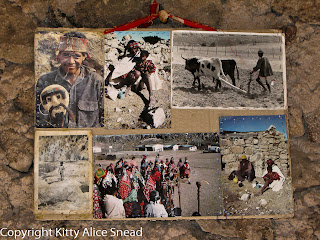 |
| Simon Morales, the mask maker |
Yesterday we left in the "burro negro" (the black van) and headed out the way we came in towards La Bandera to look for Simon Morales, the old mask maker. We stopped a Tarahumara woman herding her goats to ask for Simon's place. She indicated we needed to go back a bit. He was down a hill off the road.
We found the place, going down a steep incline. There appeared to be no one home, the 1st house was closed up tight. Beyond a cornfield was a larger house with raised grain storage huts and animal pens. Both compounds had pens and were behind rock walls about 4 feet tall. We could see a young woman stirring around outside the far compound.
As we passed the 1st smaller compound I could see "animalitos", or small toys on the window sill and I said to Beto, "this is Simon's place".
 |
| Beto at Simon's |
When we approached the woman, Santiago asked if she knew Simon. She indicated the 1st adobe home was his but he was not home. We headed back for the "burro negro" at the top of the hill. It is steep and I struggled, pulling for air stopping to rest several times before I got to the top. We climbed in the van and headed back to Nararachi. It seems Simon has two homes with the 2nd located up on the mesa behind the church and towards the air strip.
The nurse, Marta, in the clinic told me before we left that Simon was probably at his home closer to Clause's place as he (Simon) had been especially invited to the party for the community. I asked if she'd seen Simon at the party and she said no, but there were a lot of people there!
As we headed back I looked to my right and saw an old man carrying a korima pail headed in the direction of Simon's. I said "stop, that's him!" Santiago wanted to argue but Samuel stopped and got out and asked the man on the path if he were Simon. Yes, indeed it was him!
That was Christmas day miracle #1.
Beto and Santiago walked with the old man back to his home. I rode the van to the top of the "killer" hill with Samuel and walked down to Simon's for the second time.
We entered his home and visited with Simon. As the old man is deaf it was hard to make him understand we were interested in watching him make a mask. But we did get the idea over to him that we wanted to buy two or three.
I began to ask if he had the wood to make one. Santiago being passive. The old man said he'd have to go down to the arroyo to get the wood-- madrono. The arroyo was not far so we asked to go with him to watch him get the wood for the mask.
Simon got his ax and off we went past the second compound, down into a ravine and up an incline. Simon knew where a large madrono was and he chopped a slab or chunk out, about 10" to 16" and we started back.
Miracle of Christmas day #2: watching a mask being made from tree to finish. I photographed his tools around the slab of wood that would beome my mask while Simon and the other men drank coffee and visited. We made arrangements to go back the next day (today) about 9-9:30 am.
When we got to Simon's today he was seated outside his wall on a log, hard at work. He had already shaped the mask and begun the process of digging out the backside. I took digital shots of the process and made a video with the little Sony digital camera.
Simon's outdoor workshop has a view out across the field to the mountains and ravines beyond. Gorgeous!
The goats came to visit and graze on the corn stalk stubs and old cobs.
We broke for lunch at 12:45. We'd brought the pinic of saltines and portales (sardines), orange soda, jalapeno condiments, some serious cheese, and cookies.
The mask needed only finish work as the old man resumed. His arm began to ache and we said "let's stop for the day". Simon agreed. We'll pick up two masks-- mine and Beto's on Friday around 2 p.m.
Before I left I took a black and white protrait of Simon-- he was tired. I'll try to do another on Friday.
I climbed the hill again and pulled for air. It's a serious climb for me.

Aside: There were snapshots on Simon's wall, one of a young man holding a mask. That turned out to be his son, Felipe who now lives and works in Cuauhtemoc in agriculture.
I asked when Simon started making masks. He said he couldn't remember-- a long time ago. Clause had got him started.
He pulled out his ID card, Simon is officially 70 years old!
 |
| Simon wearing the finished mask |












